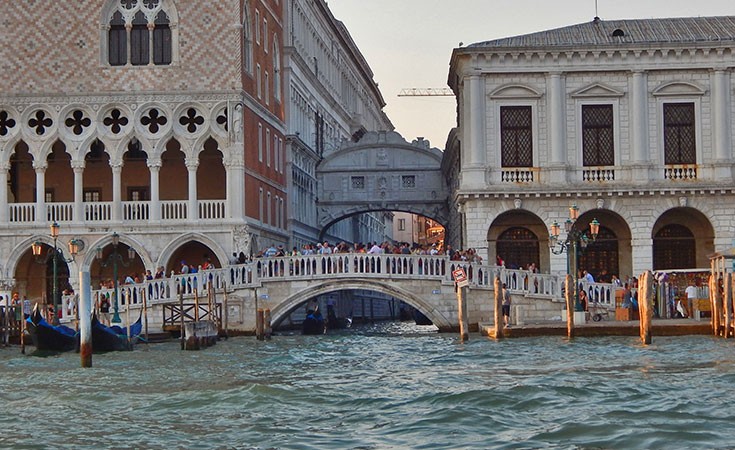
The Bridge of Sighs is one of the best-known and most photographed tourist attractions in Venice. The main reason for this is that it is so close to the city center and because it has an interesting story behind it.
The Bridge of Sighs was constructed in 1602 by the will of Doge Marino Grimani with the aim of connecting Doge’s Palace with the new prison. So called New Prison (prigioni nuovi) built in 1580 was separated from the Doge’s Palace by the canal called Rio di Palazzo.
The bridge was built out of Istria white marble and in Baroque style with completely closed structure that would prevent any desperate attempt of escaping. The bridge served the purpose of transporting the prisoners from the prison to the council and torture rooms where they would be interrogated.
Interestingly, the name of the bridge is owed to romanticism literature according to which the prisoners’ sighs could be heard as they crossed the bridge for the last time after having heard their sentence. While crossing the bridge on their way back to their prison cells, they could also see the Venetian lagoon for the last time.
Interesting facts
It was not hard to end up in prison during the reign of the Venetian Republic, as there was a large network of informers who would declare any violence or theft they have witnessed or heard about.
The diet of the prisoners consisted of only bread, water and wine. The bread was almost inedible, because the local merchants didn’t want to add yeast and would dampen it so that they would earn more, as the weight was the only criteria for the purchase. The wine, on the other hand was mixed with water first by the merchants and then by the prison guards, who were known as drunkards.
Some prisoners would remain in prison even after they have served their sentence. When the sentence expired, prisoners had to pay for the cost of processing the sentence and their imprisonment, so those who had no money would remain imprisoned. Therefore, there were charities organized around the city with the purpose of gathering funds for the release of those unfortunate ones and the repayment of debt.
 The most famous prisoner was the philosopher, writer, secret agent, adventurer, but above all the most famous seducer and the lover of all times. In 1756, Giacomo Casanova was imprisoned in the section of the prison called i piombi (lead), because this section reserved for the prestigious prisoners. So he was located under the roof of the building covered with lead plates, and accused of libertinism and fraud. This section of the prison was considered extremely safe, but Casanova together with an accomplice managed to make a hole in the roof and to reach a courtyard of the palace by crossing the roof. There he was noticed by a palace guard, who sure of that Casanova was a visitor that remained locked in place after the closing hours by mistake, opened the gate of the palace and let him go.
The most famous prisoner was the philosopher, writer, secret agent, adventurer, but above all the most famous seducer and the lover of all times. In 1756, Giacomo Casanova was imprisoned in the section of the prison called i piombi (lead), because this section reserved for the prestigious prisoners. So he was located under the roof of the building covered with lead plates, and accused of libertinism and fraud. This section of the prison was considered extremely safe, but Casanova together with an accomplice managed to make a hole in the roof and to reach a courtyard of the palace by crossing the roof. There he was noticed by a palace guard, who sure of that Casanova was a visitor that remained locked in place after the closing hours by mistake, opened the gate of the palace and let him go.